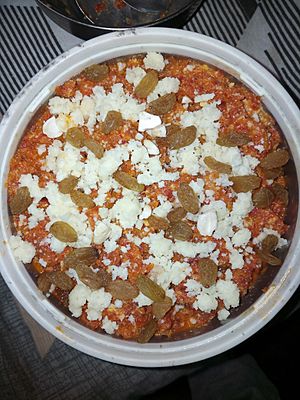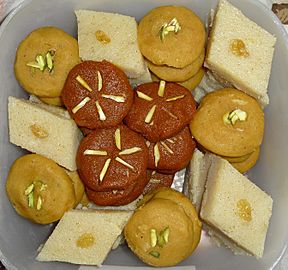Gajar ka halwa facts for kids
 |
|
| Alternative names | Gajar ka Meetha Pak, gajrela, gajorer halwa gazoror halwa, carrot pudding, carrot halwa, Gajar Pak |
|---|---|
| Course | Dessert |
| Place of origin | Indian subcontinent |
| Region or state | Indian subcontinent |
| Associated national cuisine | India, Bangladesh, Pakistan, Nepal |
| Serving temperature | Hot or cold |
| Main ingredients | Carrots, milk, water, ghee, sugar, khoya |
| Variations | Black carrot halwa, red carrot halwa, carrot and beetroot halwa, cheesy carrot halwa |
Gajar ka halwa is a yummy sweet dish from Punjab, a region in the Indian subcontinent. You might also hear it called gajorer halua, gajrela, gajar pak, or carrot halwa. It's a type of pudding made mostly from carrots.
To make it, grated carrots are cooked in a pot. They are mixed with milk, sugar, and a spice called cardamom. People stir it often while it cooks. It's usually served with a sprinkle of almonds and pistachios. These nuts are often lightly cooked in ghee, which is a type of clarified butter.
This dessert is a favorite during many festivals in India. These include Diwali, Holi, Eid al-Fitr, and Raksha Bandha. It's especially popular to eat it warm during the winter months.
Contents
What is Gajar ka Halwa?
Gajar ka halwa is a tasty mix of carrots, milk, sugar, khoya (which is dried milk solids), and ghee. It's a light and healthy dessert. It has less fat than many other sweet treats from the Indian subcontinent. This makes it a good choice for many people.
This dessert can last for a medium amount of time. Because of this, it is sometimes sent to other countries. During festival times, many people like to eat vegetarian dishes. Gajar ka halwa fits this perfectly. It's low in fat, vegetarian, easy to make, and tastes great. This makes it a very popular dessert all over India. Both kids and adults love it. A serving of about 300 grams has about 268 calories.
Where Did Gajar ka Halwa Come From?
Gajar ka halwa first appeared during the Mughal Empire in Punjab. The name "halwa" comes from an Arabic word. It means "sweet." The word "gajar" means "carrot" in Hindi. So, "gajar ka halwa" means "carrot sweet" or "carrot pudding." It is strongly linked to the food of Punjab. It is very similar to other types of halwa from that region.
The first gajar ka halwa recipes were simple. They used carrots, milk, and ghee. But over time, new ingredients were added. Today, many recipes include mava, which is another name for khoya. This old recipe has been in Punjabi cookbooks for many years. When made with milk and carrots, it's called milk flavored gajar ka halwa. If it uses cream or mava, it's known as mava flavored gajar ka halwa.
How to Make Gajar ka Halwa
The main ingredients for gajar ka halwa are fresh grated carrots, milk, sugar, cardamom, khoya, and ghee. You can change the amounts to fit your own taste. If you don't want sugar, you can make a sugar-free version.
People usually cook gajar ka halwa in a cooker or a kadai (a type of cooking pot). Some chefs, like Vasundhara Chauhan, say it's best to cook it slowly. They believe using a pressure cooker can spoil the dish. First, the carrots must be grated. Then, they are often dried a bit before cooking.
The grated carrots go into a hot pan. Milk or khoya and sugar are added. After stirring for about 4–5 minutes, chopped cashew nuts are mixed in. About 10–15 minutes later, pure ghee is added. Finally, it's often decorated with almonds and pistachios before serving.
Different Kinds of Gajar ka Halwa
There are many fun variations of gajar ka halwa. In carrot-papaya halwa, people use equal amounts of carrot and papaya. First, they mix grated carrot and papaya. This mix is cooked in a kadai or cooker with ghee for about 5 minutes. The rest of the steps are the same as the basic recipe. This version is popular because papaya adds a different flavor.
Red velvet carrot halwa is another famous type. It's made by heating a lot of milk cream with carrots, sugar, rose water, and saffron. This is cooked slowly over low heat. Red velvet carrot halwa is also a good source of Vitamin A and Calcium.
Other less common types include Carrot and beetroot halwa and cheese gajar ka halwa. There's also khajur gajar ka halwa and other carrot desserts. These variations are popular in different places or with different people. But the traditional gajar ka halwa is still the most loved. For carrot and beetroot halwa, grated beetroot is added to grated carrots. This mix is heated in a kadai on low heat. Then, mava and sugar are added. After about 30 minutes of stirring, it's ready. Cheese gajar ka halwa uses purple carrots and ricotta cheese. This dish is popular in northern India, where purple carrots grow.



